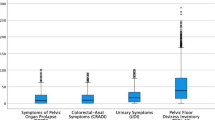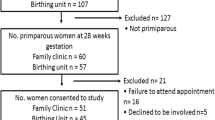Abstract
To assess the occurrence of pelvic floor dysfunction (PFD) in pregnancy- related low back and pelvic pain (PLBP) patients, a cross-sectional study was performed, comprising 77 subjects. Each subject underwent physical assessment, and filled in the Urogenital Distress Inventory completed with gynaecological questions. Differences in the presence of PFD between PLBP patients and healthy controls as well as differences in pelvic floor muscle activity were tested for significance. Interaction by age and vaginal delivery were tested. PFD occurred in 52% of all PLBP patients, significantly more than in the healthy control group. In PLBP patients a significantly increased activity of the pelvic floor muscles could be demonstrated with respect to healthy controls. The occurrence of PFD and PLBP was influenced by a confounding effect of age. Clinicians should be aware of the relation between PLBP and PFD and hence address both problems at the same time.
Similar content being viewed by others
References
Östgaard HC, Roos-Hansson E, Zetherstrom G (1996) Regression of back and posterior pelvic pain after pregnancy. Spine 21:2777–2780
Wu WH, Meijer OG, Uegaki K, Mens JM, Van Dieen JH, Wuisman PI, Ostgaard HC (2004) Pregnancy related pelvic girdle pain (PPP),1: Terminology, clinical presentation and prevalence. Eur Spine J 27 (on line)
Mens JMA, Vleeming A, Snijders CJ, Stam HJ, Ginai AZ (1999) The active straight leg raising test and mobility of the pelvic joints. Eur Spine J 8:468–473
Östgaard HC, Zetherstrom G, Roos Hansson E (1997) Back pain in relation to pregnancy: a 6-year follow-up. Spine 24:2945–2950
Mens JMA, Vleeming A, Snijders A, Koes BW, Stam HJ (2001) Validity and reliability of the active straight leg raising test in posterior pelvic pain since pregnancy. Spine 26:1167–1171
Östgaard HC, Zetherström G, Roos-Hansson E, Svanberg B (1994) Reduction of back and posterior pelvic pain in pregnancy. Spine 19:894–900
O’Sullivan PB, Beales D, Beetham J, Cripps J, Graf F, Lin I, Tucker B, Avery A (2002) Altered motor control strategies in subjects with sacroiliac joint pain during the active straight leg raise test. Spine 27:E1–E8
Dietrichs E, Kogstad O (1991) “Pelvic girdle relaxation”- suggested new nomenclature. Scan J Rheum suppl 88:3
Mens JMA, Vleeming A, Stoeckart R, Stam HJ, Snijders CJ (1996) Understanding peripartum pelvic pain, Implications of a patient survey. Spine 21:1363–1370
Pool-Goudzwaard AL, Vleeming A, Stoeckart R, Snijders CJ, Mens JMA (1998) Insufficient lumbopelvic stability- a clinical, anatomical and biomechanical approach to a-specific low back pain. Man Ther 3:12–20
Council for organizations of medical sciences (2002) The committee on the Spine. American Academy of orthopaedic surgeons, Chicago, Document 675–680
Snijders CJ, Snijder JGN, Hoedt HET (1984) Biomechanische modellen in het bestek van rugklachten tijdens de zwangerschap. T Soc Gezondheidszorg 62:141–147
Damen L, Spoor CW, Snijders CJ, Stam HJ (2002) Does a pelvic belt influence sacroiliac joint laxity? Clin Biomech (Bristol, Avon) 17:495–498
Vleeming A, Buyruk HM, Stoeckart R, Karamursel S, Snijders CJ (1992) An integrated therapy for peripartum pelvic instability: a study of the biomechanical effects of pelvic belts. Am J Obstet Gynecol 66:1243–1247
Pool-Goudzwaard AL, Hoek van Dijke G, Gurp van M, Mulder P, Snijders CJ, Stoeckart R (2004) Contribution of pelvic floor muscles to stiffness of the pelvic ring. Clin Biomech 19:564–571
Avery AF, O’Sullivan PB, McCallum MJ (2000) Evidence of pelvic floor muscle dysfunction in subjects with chronic sacro-iliac joint pain syndrome. In: Proceedings of the 7th scientific conference of the IFOMT. Perth 35–38
Velde van der F (1999) Psychophysiological investigation of the pelvic floor. The mechanism of vaginismus. Thesis, Free University of Amsterdam
Freese M, Levitt EE (1984) Relationships among intravaginal pressure, orgasmic function, parity factors and urinary leakage. Arch Sex Behav 13:261–268
Bernstein IT (1997) The pelvic floor muscles: muscle thickness in healthy and urinary- incontinent women measured by perineal ultrasonography with reference to the effect of pelvic floor training. Neurour Urodyn 16:237–275
Meyer S, Schreyer A, De Grandi P, Hohlfield P (1998) The effects of birth on urinary incontinence mechanisms and other pelvic floor characteristics. Obstet Gynecol 92:613–618
Handa, VL, Harris TA, Ostergard DR (1996) Protecting the pelvic floor: obstetric management to prevent incontinence and pelvic organ prolapse. Obstet Gynecol 88:470–478
Östgaard HC, Zetherström GBJ, Roos-Hansson E (1994) The posterior pelvic pain provocation test in pregnant women. Eur Spine J 3:258–260
Laycock J (1992). The development and validation of a pelvic floor digital assessment scheme. Assessment and treatment of pelvic floor dysfunction. Thesis, University of Bradford
Shumaker SA, Wyman JF, Ubersax JS, McClish D, Fantl JA (1994) Health related quality of life measures for women with urinary incontinence: the icontinence impact questionnair and the urogenital distress inventory. Qual Life Res 3:291–306
Vaart van der CH, Leeuw de RJ, Roovers JPWR, Heintz APM (2001) Measuring health related quality of life in women with urogenital dysfunction: The urogenital distress inventory and incontinence impact questionnair revisited, Thesis, University of Utrecht
Heitner CP (1999) Valideringsonderzoek naar palpatie en myofeedback bij vrouwen met stress-urine incontinentie. Maastricht University
Binnie NR, Kawimbe BM, Pfapachrysostomou N (1991) The importance of the orientation of the electrode plates in recording the external sphincter EMG by non invasive anal plug electrodes. Int J Colorect Dis 6:5–9
Katz MH (2003) Multivariable analysis: a primer for readers of medical research. Ann Int Med 138:644–650
Vereecken RH, Verduin H (1970) The electrical activity of the paraurethral and perineal muscles in normal and pathological conditions. Br J Urol 42:457–463
Loenen NTVM, Vierhout ME (1997) De invloed van een bekkenbodem contractie op het urethradruk profiel. Profundum 2:9–15
Sapsford R, Bullock-Sanxton J, Markwell S (1988) Women’s health. Saunders, London
Acknowledgements
The authors would like to express their gratitude to all physiotherapists who participated in the study, the Dutch Association of Pelvic Physical Therapists (NVFB) for their financial support and to Ria van Kruining.
Author information
Authors and Affiliations
Corresponding author
Rights and permissions
About this article
Cite this article
Pool-Goudzwaard, A.L., Slieker ten Hove, M.C.P.H., Vierhout, M.E. et al. Relations between pregnancy-related low back pain, pelvic floor activity and pelvic floor dysfunction. Int Urogynecol J 16, 468–474 (2005). https://doi.org/10.1007/s00192-005-1292-7
Received:
Accepted:
Published:
Issue Date:
DOI: https://doi.org/10.1007/s00192-005-1292-7




